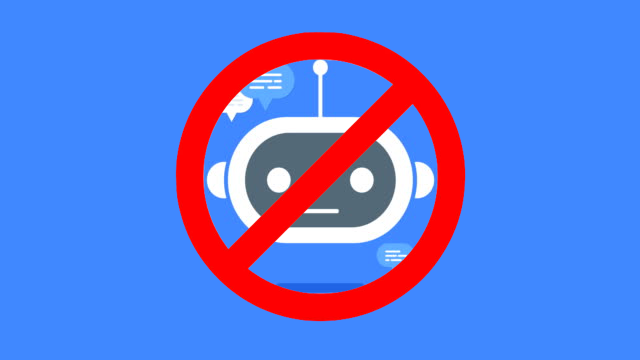No One Wants To Talk To Your Chatbot

Dearly beloved, we are gather here today to talk about this thing called chat. Electric word, “chatbot”. It means automation of human interactions and that’s a mighty cost effective thing. But I am here to tell you, no one wants to talk to your chatbot.
So before you call up your programmers, and ask them about ChatGPT. Before you launch yet another automated calling system or virtual assistant, put down the Large Language Model. Don’t go crazy. It’s all be done before…
Party Like It’s 1999
In the late 90’s, it was a race to build commercial websites. We imagined that users would create direct relationships with our URLs. We imagined there would be brand loyalty. We scrambled to buy meaningful domain names. (My company sold start.com to Microsoft. We were very excited!).
In our glorious future, websites would be the next generation of applications. Just like millions of users clicked on an Excel or Word icon on their desktops, millions would launch our websites from their bookmark bars. We were the apps and the browser was the new OS.
But of course, that isn’t how it worked out. It was the search engines that became to the entry point for users. We watched most users launch their browsers to Google and then search for us.
We tried everything to get them to come to us directly. We added buttons to our sites that would automatically bookmark us. We worked with browser and computer manufacturers to pre-install our links. There is a still a host of shady browser toolbars and plugins that try to get their sites directly in front of users.
But the users have spoken. In response, we have created SEO, a whole new field of marketing to search engine algorithms in hopes that down the line they will market us to humans.
We are the apps. The browser is the new OS. But the search engine turned out to be the main interface. It is the shell that wraps all the apps.
Rise of the Apps
In 2007, 14 years after the launch of the web, 9 years after Google introduced their search; the iPhone launched. There had been other mobile platforms that came earlier, but none that reached the scale of the iTunes App Store (Now just the App Store).
All of a sudden, our dreams were coming true. We had our icons on the screen. Users launched us directly. Once installed, we didn’t have to continually re-invest in SEO for users to find our app versus others. Our websites became apps and we had full relationships with our users. Or, so we thought.
Apps were the new applications and iOS/Android was the new OS.
Apps are not Applications.
Apps are limited. They fit on smaller screens and can be used with only a few finger swipes and clicks. They don’t have mice, right-clicks, and sub-menus. Users don’t save and open files. Apps, and users, rely on their host OS for most advanced functions.
The OS handles payments, security, sharing, etc. As more features get handled by the OS, the more they become first point of contact with the user. The more the user has a relationship with their device and less with their apps.
Rise of the Assistants
In 2010, Apple launched Siri on MacOS (OS X back then) and added it to their iPhones in 2011. MicroSoft and Amazon followed suite in 2014 and Google’s assistant joined in 2016. Microsoft shutdown their assistant, Cortana, in 2020, but their voice assistant has merged with their search as part of Bing. (MicroSoft has been trying to crack the virtual assistant market since 1997 with Clippy!)
Up until now these voice powered personal assistants have been mostly curiosities, used for simple tasks like checking the weather, turning on or off lights, or playing music.
But if you look at the OS APIs, each company has been creating deeper integrations with their virtual personal assistants and their hosted Apps. iPhone and Android allow apps to chat through their assistance, expose functionality, and offer input. Siri can pull weather from one app, your calendar from another, and check traffic and directions from a third to offer you a complex and well informed dialogue.
Amazon’s Alexa is more direct. In addition to accessing your apps, developers can create Amazon Alexa Skills, programs which expand your Alexa virtual assistant with new capabilities. Skills can only be accessed via Alexa. Users talk to Alexa and skills respond back through her and in her voice.
Language Has Been the Logjam
Up until now, all of these virtual assistants have been held back by their lack of language skills. Anything beyond simple tasks become either comical and/or frustrating. You can get stonewalled by a benign “I don’t understand” to sidetracked by your assistant totally misunderstanding your request and launching the wrong thing.
Suddenly with Large Language Models (LLM) and each of these companies running their own LLM as a Service, these virtual assistants will see massive upgrades. Now they will understand not just you, but also the output of of your apps and skills.
The Relationship Is With The Assistant
Apple and Amazon sell hardware. They are less interested in trying to monetize free users. Google and MicroSoft do both, but still want to own your device and assistant. They sell the operating system (and bundled assistant) that powers much of our hardware.
Their devices are in our pockets and our houses. We trust these companies with our personal clouds: our payments, our histories, our contacts, our logins, etc. They are the first devices we interact with when we wakeup and the last screens we stare at before going to sleep. We know their names and voices.
We have been trained to call on them personally and we don’t switch easily. We have all seen a frustrated friend trying to talk to our Alexa by asking it “Hey Siri,” and trying to figure out why she won’t respond.
With LLM, these personal virtual assistants are the new starting point. They will be to apps what Google and Bing are to the web.
Few people will be willing to interact with an army of different chatbots and online assistants. They will expect these other chat enabled systems to speak to and through their personal virtual assistant. They will log into their smart phone and expect all the other apps and skills to integrate with their personal clouds, arbitrated by their trusted personal virtual assistant.
When they do come directly to your site or app, they are not looking for a chatbot. They are looking for a UI that works. They know why they came to you. They expect your UI to do what it should do.
If you have a chatbot, it is for Sir or Alexa to use, not people. I am here to tell you, no human wants to talk to your chatbot.
